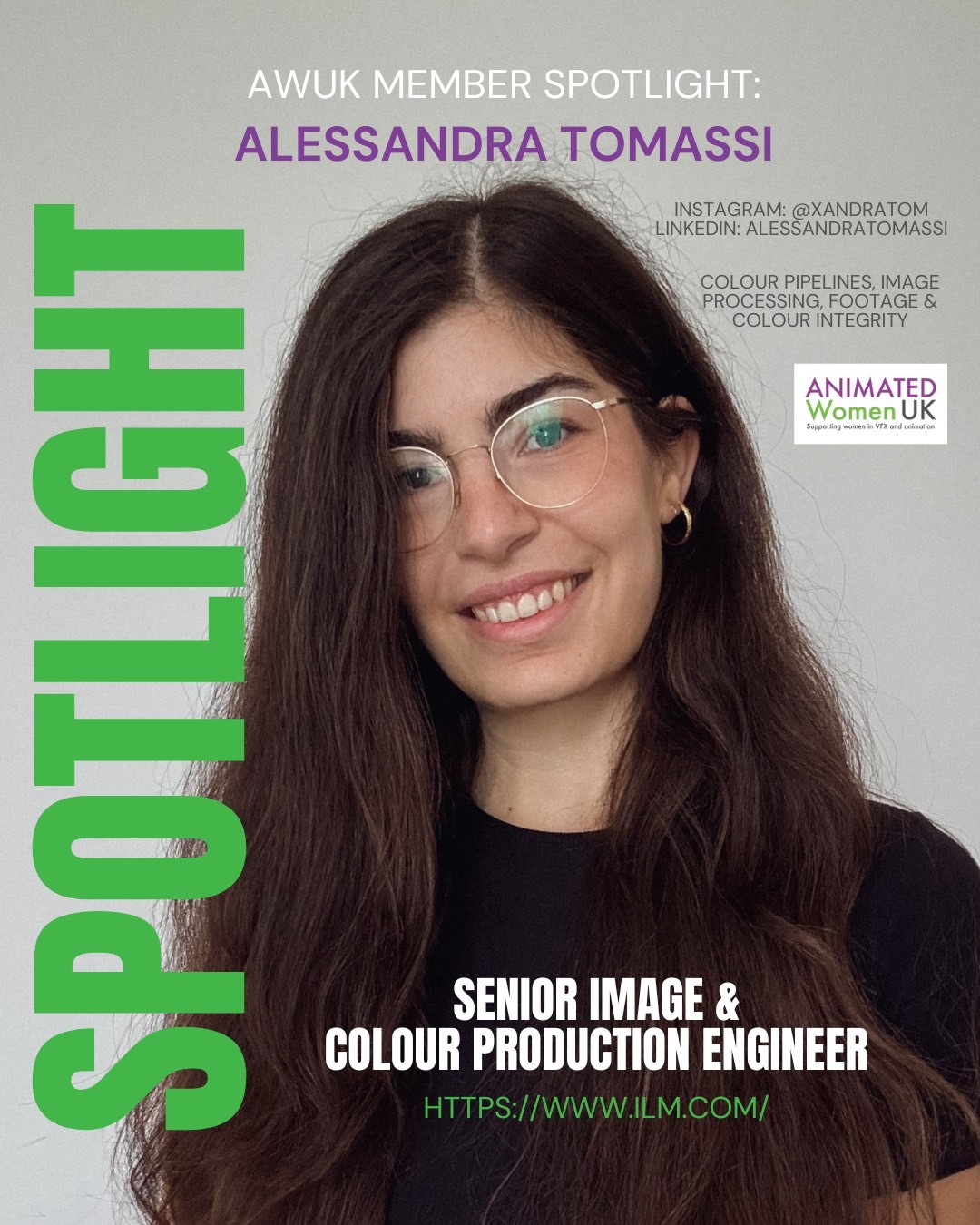
Spotlight: Alessandra Tomassi
What's your name and what area of VFX or animation do you work in?:
Hello! I’m Alessandra Tomassi, Senior Image and Colour Production Engineer working for the Colour and Image team at Industrial Light & Magic London.
What was your journey into the VFX or animation industry? What got you into VFX or animation?:
I grew up surrounded by computers, touched a keyboard before I even picked up a pen. But I liked art, music, books and most of all: movies.
My good relationship with technology and scientific subjects led me to study Computer Science, and, for a moment, I felt like I might have steered my career away from anything creative and I might have lost my chance to work in cinema. Now I know better about all the different talents that are needed in the field!
When I started looking into how to use what I had learned in the world of cinema, that’s how I ended up in VFX. I started as a Technical Assistant, then moved to the Pipeline team, where I began specialising with the Colour and Image team.
What does a typical day look like in your role?:
Macbeth Colour Checker charts, gray spheres, lenses, cameras, LED walls…
I spend most of my time on my computer, checking footage and developing and managing the pipeline that is needed for its colourful journey from camera to final product. I have the chance to work on many different projects, interface with various technologies and, on the odd day, I get to help on set, which will never stop feeling like a dream come true.
What skills do you think are most important for your role?:
All those expected from a software engineer, plus good communication skills: there are many exchanges between my team and many other departments, both within and outside the office. And math knowledge is a must!
What tools or software do you use daily? Is this what you started working in or have you pivoted to this one?:
There’s always a Nuke session open on my screen, ever since the first day I started working in Colour and Image. OpenColorIO is also an invaluable tool in my arsenal.
What's your favourite part of your job/career so far?:
Days on set are always intriguing and intense.
I am very happy whenever a new project, a new technology or a new requirement in VFX and cinema offers a never-seen-before challenge, and I get to deep dive with the team into a new fun mystery of Colour Science.
And, it might be trivial, but I cannot not mention this: I will never not smile when reading my name in the final credits of a movie.
What's a common misconception about your job?:
I am not a colourist!
When I mention working in Colour Science, people always assume I work as a colourist, but they are very distinct roles. While a colourist is a creative artist who manipulates the colour to enhance or define the aesthetic of a video or image, as a colour engineer I work with physics, math and computer science to maintain colour integrity of the footage that passes through the VFX pipeline and to manage the generation of final media for its correct reproduction.
What challenges have you met as a woman in the industry?:
I have never felt treated differently as a woman in my career path.
However, there have been moments that have challenged my confidence and my happiness during my university studies. Being one of the few women in an all male student body and an all male faculty staff, I would hear sentences like “you only passed the exam because you’re a girl”. It’s easier to strengthen up, to not give credit to such remarks and to challenge whoever doubts you or your female peers if you’re surrounded by family and friends who believe in you. That’s why I consider myself lucky, especially having now met so many women who have had way different experiences.
What's one piece of advice you wish you'd received earlier?:
You don’t need to have a clear passion from the beginning: you can build your path along the way, one step at a time.
I remember, during my teenage years, looking with envy at all of those who ambitiously already spent most of their time on the passion they wished to turn into a career.
I learnt not to judge myself for being spread “too wide, too thin”: people are built differently and, at the same time, there’s not much difference between those who know where to go and those who don’t: we all might hit bumps on the road.
Just keep on moving. Be confident in your capabilities, don’t forget what makes you happy and don’t be scared to go with the flow.
How do you balance work with your personal life?:
It’s very easy to be consumed by work, especially when work and passion coincide. So even though I am happy to give more when more is needed, to keep going till you reach a “mission accomplished”, I always stay objective and never forget to invest at least as much heart and time in my personal life. And often, inspiration strikes when you take a breath.
What's one stereotype you'd love to break about your field?:
Recently, there is a popular opinion that movies are better without CGI, when in fact many of the films quoted or claimed by actors and directors as “CGI free” have actually been worked on by many hundreds of VFX artists.
There are very, very few “no CGI” films produced these days, and I would love for audiences to have a better understanding of what the VFX process actually involves. Part of that requires transparency from studios, actors, and directors as to how the filmmaking process uses VFX today.

